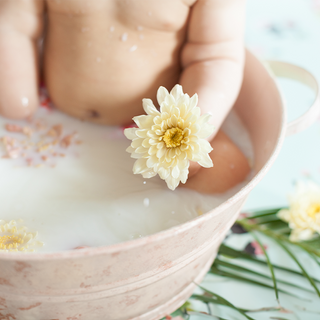
Pumping milk regularly is a great way to help increase and maintain your supply of breastmilk. Not only does it help you build up a good milk stash for future use/when you’re not around to breastfeed, but it also helps keep up your milk supply so that you can continue to breastfeed for longer. You might even resort to pumping exclusively for your little one if breastfeeding is not possible. Either way, regular pumping can be extremely beneficial for both you and your baby. Here are some of the most helpful tips to make pumping milk easy and to help you increase your breast milk production.
1. Express milk either by nursing/pumping at least 8-10 times daily in 20-minute sessions
The more you empty your breasts out by nursing/pumping, the more milk your body will produce. In the beginning, nurse/pump at least 8-10 times in a span of 24 hours. Let each session last for a minimum of 20 minutes at least. If you set a pumping schedule and then start skipping sessions, it will signal to your body that your baby needs less milk.
2. Invest in a high-quality double electric breast pump and a cheaper manual one as well
A good pump can help save a lot of time and stress. If you’re pumping regularly, a double electric breast pump is a good investment. It works to pump milk from both breasts at the same time. If you’re ready to shell out a little extra, there are even hands-free wearable pumps available these days, that are small enough to fit inside your bra and pump as you go about your daily activities. You could even rent out a hospital grade breast pump which has a much stronger suction, if you’re solely pumping. In addition to an electric pump, buy a manual one as well. Manual breast pumps are pretty cheap so it will not be much of an added cost. Here’s why you’ll need it –You can use it quickly at the end of a nursing session to empty your breasts completely. Due to its relatively smaller size, it’s easier to carry and use if you need to pump when you’re not at home. Some women even use a manual pump right before a nursing session to help stimulate the milk flow.
3. The size of your flange or breast shield can make a difference
If your breast pump shield is either too small or too big, it can cause discomfort and even hamper your milk production. To avoid this, make sure you get a breast shield that’s the right size. Based on the diameter of your nipple, you can choose a breast shield that’s right for you. For many women, this size could even change over the course of your pumping journey.
4. Learn how to assist milk letdown
To help your milk start flowing while pumping, try sitting close to your baby if you’re at home as the touch or smell of your baby can help stimulate flow. If you’re away from your little one, try looking at a picture or video of your baby. Many moms also find it helpful to take a warm shower right before pumping or simply use a warm compress on your breasts. Gently massaging your breasts with your hands can also help encourage expression. Try expressing milk by hand, both before and after you pump. Make sure you sit in a calm environment and relax while you pump.
5. Equip yourself with all the right pumping essentials beforehand
Here are all the essentials you’ll require when you start pumping milk – breast pump, nursing bra, nursing cover, breast milk storage containers or breast milk storage bottles, warm & cold compresses, baby wipes and nipple cream.
6. Adjust the pump speed correctly
If you can control the speed of your breast pump manually, then it helps to typically start off at a higher speed and then bring it down to a medium or lower speed once the milk has started flowing freely. This works well for many moms as it mimics the manner in which your baby nurses at the breast.
7. If you’re mainly nursing your baby, try pumping early in the morning
If you’re nursing majority of the time and pumping only once a day, try and do it when your milk supply is generally more. A lot of moms prefer pumping first thing in the morning or an hour after your morning feed.
8. Try pumping one hour after baby finishes breastfeeding
If you are mostly breastfeeding, then try to squeeze in pumping sessions about 30-60 minutes after your baby finishes nursing. This will help you empty out your breasts properly and will make sure there’s enough time for your milk to come in before your next nursing session.
9. Don’t miss a nighttime pumping session
Skipping a nighttime nursing/pumping session can lower your milk supply and can leave you feeling pretty uncomfortable in the morning.If you’re exclusively pumping, then pump every time your baby gets up to feed at night. As your baby grows older, you can reduce the frequency of pumping sessions.
10. Don’t stress about quantity
Any kind of stress can have an adverse effect on milk production. Try not to put too much pressure on yourself. If you think that you aren’t able to produce enough milk, speak to your doctor or lactation consultant to discuss techniques to boost your milk production or to supplement breast milk with formula.
11. Keep your pump in good condition by cleaning well and following maintenance instructions
Due to constant use, your breast pump is exposed to a little wear and tear. Try and keep it in optimum condition by cleaning the parts well and following any maintenance and care instructions.
12. Try the power-pumping method to increase low milk supply
Power-pumping is a technique that can help increase your breast milk production by mimicking how often and how long your baby would feed during a growth spurt. (During growth spurts, babies tend to feed longer and more often, as opposed to their regular routine)
By using this technique to pump, your body receives the signal to produce more milk. If you want to try this method, here’s how it works - First pump for a total of 20 minutes. Then take a quick 10-15 minute break and pump once again for 10 minutes. Take another 10-minute break after which you should finally pump for 10 more minutes. Try this once daily for a week and notice the difference in your milk supply. For even greater results, you can try doing it thrice a day for 3 days in a row.
13. Pump and breastfeed at the same time
Baby on one breast and the pump on the other. This can take some getting used to, but will help you save time in the long run and can increase supply.
14. Eat foods that help lactation and drink lots of water
Certain foods can help boost lactation. Add these to your breastfeeding diet. Click here for our list of foods that can help increase breast milk supply. Make sure you increase your water intake as well.
15. Store your expressed milk correctly
Every bit of pumped milk counts so make sure you store your milk correctly for future use. Store in airtight plastic/glass bottles, or in breastmilk storage bags. Use waterproof labels on the container with the date of pumping, amount of milk, and your baby’s name. Cool down the pumped breastmilk soon and store in a refrigerator. Freeze it if you aren’t going to use it quickly. Expressed breastmilk that is properly stored in the refrigerator should ideally be used within 4-8 days. You can also store this milk in the freezer for up to 6 months. To prevent wastage, try and store it in the amount that you will need at each feeding (2-4 ounces) since breastmilk cannot be refrozen.



















